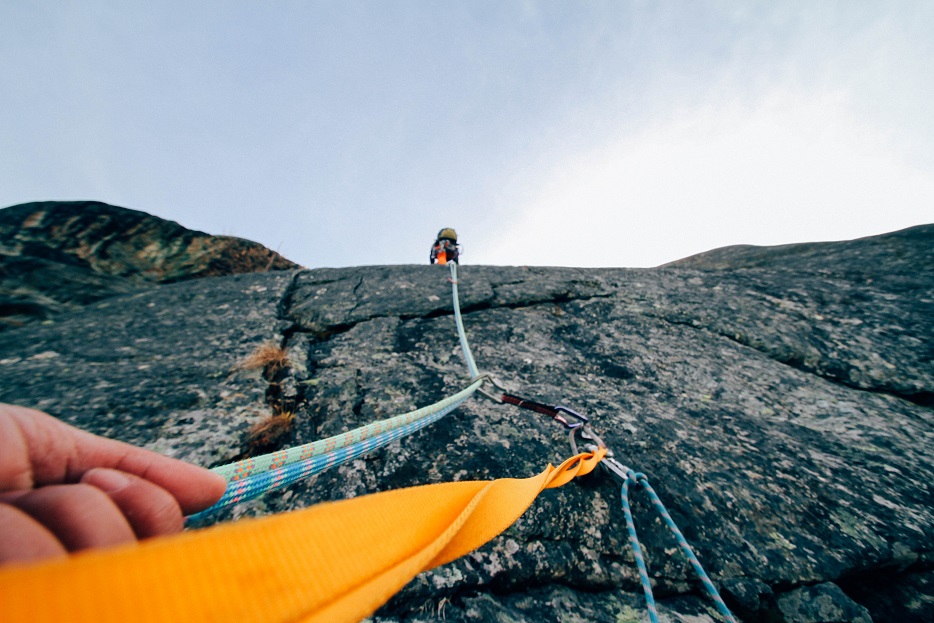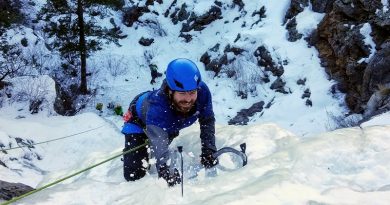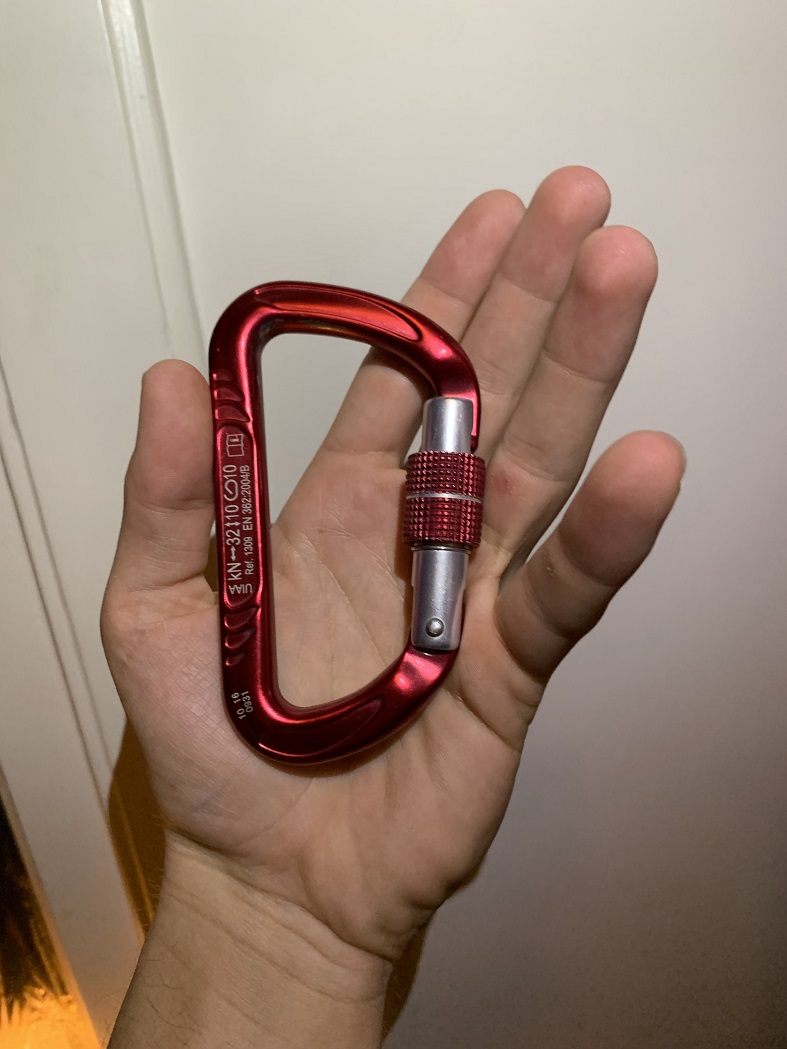In life, there are times when you can’t afford to make a mistake.
This is something belayers know all too well.
With their rock climbing partner’s lives in their hands, belayers are tasked with the incredible responsibility of preventing serious and even fatal accidents.
If you’re looking to get into rock climbing, it’s absolutely critical that you understand the role of the belayer, as well as some of the most common and dangerous mistakes belayers make.
As you practice proper belayer technique, be on the lookout for the following mistakes so that you and your partner can have a safer climbing experience.

What is Belaying?
Before we get started, let’s take a brief moment to look at the responsibilities of the belayer.
Belaying is the process in which an individual watches their partner as they climb and in which they manage both the rope and the belaying device to help lower them if needed. They’re also needed to help catch climbers in the event of a fall.
Check out our top ten list of the most common belaying mistakes below to better protect you and your partner from serious risks or injuries.
1. Using the Wrong Grip
One of the first things a belayer learns is how to have the proper grip. Having the incorrect grip can prove fatal in the event of an emergency, as it can prevent the belayer from reacting to the situation in time.
A common grip mistake is holding the inactive portion of the rope with the thumb pointed away from the device. This grip makes it incredibly difficult to firmly grasp the rope if needed to prevent an accident.
Keep in mind that the brake hand should be held under the device. If both hands are above the belaying device, the rope can slip through if the climber falls, and the speed of the moving rope can make it impossible to grab.
2. Using the Wrong Knot

Make sure that you and your partner are both using the correct type of knot when setting up the belay device.
While you’re going to want your partner to use a Figure 8 knot to tie into the harness, you’ll need to tie a stopper knot to the end of the rope.
Messing up this step can cost your partner their life.
Tying into the harness correctly helps protect the climber by attaching them to the safety device. It’s important to make sure that you’re tying the knot in the correct place, as well, because tying it on the opposite side of the harness can cause the rope to get twisted. In the event of a fall, this can sling the climber in different directions, making it dangerous even if the belayer manages to catch them.
Additionally, the knot at the end of the rope must be tied in order to prevent the rope from sliding through the belayer in the unfortunate event that the climber falls. Without this stopper knot, there will be nothing to prevent the rope from sliding completely through, effectively making the belaying device useless.
Making sure to perform this step correctly can save your partner’s life—so be sure not to mess it up.
3. Not Performing a Safety Check
Before starting your climb, you and your partner should both check to make sure that you’ve set everything up safely.
Have you tied your knots correctly? Are they tied in the right spots? Is everything the way it should be?
It’s important that both the belayer and the climber make sure that everything is set up correctly to avoid any mishaps.
Double check each other. As there’s something you might have missed, it’s always a good idea to have both partners do a look over to ensure the correct set up.
4. Not Having Proper Belaying Stance
Having proper belaying stance can help your partner in the event of a fall.
It can also keep you engaged and better grounded so that you can respond appropriately if need be.
Without the proper stance, your response time will be dramatically reduced, making it more difficult for you to protect your partner.
The goal of your stance is to help counterbalance your weight with that of your climbing partner, as well as allow you to control the length of the rope to allow for the safest descent.
Additionally, with the proper stance, you can be more prepared to brace yourself to keep from being knocked into the wall in the case of a fall.
If you’re caught off guard, the extra weight can pull you off your feet and cause harm to both you and your partner.
Being sure to follow correct stance techniques can help you both stay safe.
5. Having Poor Communication
Establishing communication with your rock climbing partner is critical. Partners should have a clear understanding of what terms means before they ever begin the climb.
Proper communication follows set rock climbing standards and is designed to allow partners to better assess the situation. This allows for a safer climbing experience.
Take a look at five common belaying commands—keep in mind, however, that this list is not exhaustive and that a proper understanding of all commands should be held by both you and your partner before going climbing.
- Belay On—Said by the belayer, this command is used to signal to the climber that the belayer is ready for them to start climbing.
- Watch Me—Something know climber wants to hear, this command signals to the belayer that the climber is worried they might fall and that they should start preparing for it.
- Slack—This command tells the belayer that the climber needs more rope in order to successfully maneuver.
- That’s Me—This command is used when the belayer is putting the rope back in their device. Eventually the climber and the belayer will feel a slight tug as all the slack runs out, and the climber will then use this command to signal to the belayer that there’s no more slack.
- Halfway—This command is said by the belayer and lets the climber know that they’ve used half of the rope.
By studying these—and other—belaying commands, you can avoid dangerous situations. By using the incorrect terminology or by responding incorrectly to a command, you may put your partner’s life at serious risk.
6. Being Too Distracted
Though it’s easy to say that this would never happen to you, don’t overestimate yourself. For new climbers and belayers, this may not be much of an issue, as you may be so focused on making sure that the process is done right that you don’t have much room for anything else.
Unfortunately, for those who are more seasoned and comfortable with the practice, it can be tempting to think that everything is under control.
This added comfort can be a detriment, as belayers look around at other climbers or things in nature instead of paying attention to their partners.
When this happens, if an emergency situation arises, the belayer will not be prepared to respond appropriately, and this can put their partner’s life in jeopardy.
Because of this, it’s of the utmost importance that belayers don’t focus on anything other than their partner who is climbing. By staying focused, everyone involved can enjoy a safer climb.
7. Not Anchoring When Needing To
While anchoring is generally deemed unnecessary these days, it’s important to realize that it can have its uses.
The act of anchoring the belayer to the ground is done to make sure that the weight of a falling climber doesn’t propel them into the air.
While this may be unlikely for people who are similar in weight, it is an issue for partners who are on opposite ends of the spectrum.
If you’re partner is significantly larger than you are, it’s probably in your best interest to anchor to the ground so that you do not have to risk being launched into the air.
If not, standard practice recommends that you don’t anchor so that you have the flexibility you need to move with the climber. This can increase your response time and your utility in the case of an emergency.
8. Using Rope That’s Too Short
Though this is more commonly a rookie mistake, it’s something that can even happen to the best of us.
It’s up to you to make sure that it doesn’t.
Having a rope that is too short can be incredibly dangerous for the climber, as it traps them in the air when they plan on coming down.
If you’re rope is too short, you could trap your partner up the mountain. Several climbers are injured or even killed each year as they attempt to come down from their climb on ropes that are too short.
This senseless mistake can be avoided by making sure that you have enough rope handy to cover the situation. By taking the time to prepare a bit more in advance, you can protect your partner’s life.
9. Not Practicing or Testing a New Device
This mistake is one that even some of the more experienced belayers will make.
When buying a new belaying device, it’s easy to assume that the upgraded equipment will make your climb safer and more convenient.
Unfortunately, that’s not always the case.
There are at least a couple reasons why you always want to check your new belaying device before attempting to make a climb.
First, it’s important that you are comfortable using it. You want to have a good idea of how it works and get a feel of how it operates. If it’s significantly different from your old device, make sure that you have a solid understanding of it before you ever use it to support your partner on their climb.
Additionally, you’re going to want to make sure that it actually works like it says.
New belaying devices aren’t immune to defects, so even if it’s supposed to be an upgrade on what you used to have, it may be a shoddy piece.
You don’t want the line to jam or any other problem to occur while your partner is in the air, so make sure you test the new device out indoors before you ever trust it with someone’s life.
10. Not Checking Your Rope
Similarly, you’re going to want to check to make sure that there are no knots or kinks in your rope before the climb—other than the required knots, of course.
What we’re talking about here are knots in the rope that you will be using to feed to your partner. Having an unexpected knot can quickly reduce the amount of rope you have available for your climb and can put your partner in an unexpected dangerous situation.
Make sure to uncoil and check the rope before each climb, even if it looks nice and correctly coiled. It’s possible for ropes to kink and knot without your knowledge, and it may not always be obvious at first glance.
By making sure that both your belayer and your rope are both in the right condition to use, you can significantly reduce the risk of either you or your partner being injured.
11. Not Wearing Safety Equipment
It can be tempting to forego safety equipment if you’re the belayer.
You’re not climbing, so you won’t be in any danger, right?
Wrong.
Be aware that as your partner climbs, rocks can become loose and dislodged from above, making it dangerous for you as you stand below and belay.
Because you’re at risk for being hit by falling rocks, helmets are essential to a belayer’s gear. Additionally, consider using other pads to protect yourself in the event that you get thrown up or into the rock wall.
The Bottom Line
Using correct belaying technique is non-negotiable. Before you and your partner start your climb, make sure that all safety precautions have been taken.
Consider the list above for eleven of the most commonly made mistakes so that you and your partner can enjoy a safe, fun climb.






